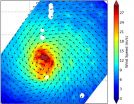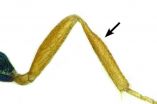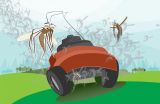Using low-dose irradiation, researchers can now edit human genes
Effectiveness of gene editing in human stem cells improves tenfold using new technique
2015-07-22
(Press-News.org) LOS ANGELES (July 22, 2015) - For the first time, researchers have employed a gene-editing technique involving low-dose irradiation to repair patient cells, according to a study published in the journal Stem Cells Translational Medicine. This method, developed by researchers in the Cedars-Sinai Board of Governors Regenerative Medicine Institute, is 10 times more effective than techniques currently in use.
"This novel technique allows for far more efficient gene editing of stem cells and will increase the speed of new discoveries in the field," said co-senior author Clive Svendsen, PhD, director of the Board of Governors Regenerative Medicine Institute.
The irradiation method could prove effective in learning more about diseases such as spinal muscular atrophy, muscular dystrophy and Huntington's disease. Gene editing allows scientists to correct irregular mutations and, theoretically, cure the disease in the petri dish. Additionally, gene-editing technology allows scientists to create disease mutations in normal cells, thus modeling human disease.
When using this form of gene editing, Cedars-Sinai scientists can more efficiently insert reporter genes that glow when a stem cell turns into a specific cell of the body. For example, stem cells would turn green when converted into a heart cell and red when turned into a neuron.
"The combination of low-dose irradiation and correct gene copy will accelerate our ability to model human disease using stem cells from patients with many different disorders," said co-senior author Vaithilingaraja Arumugaswami, MVSc, PhD, director of the Pancreas and Liver Program in the Cedars-Sinai Board of Governors Regenerative Medicine Institute.
Over the past few years, the field of creating human diseases in the dish using stem cells has expanded rapidly. This work allows scientists to test novel drugs on human cells that carry disease-causing genes.
"This new technique will help us establish far more accurate models and accelerate the discovery process," said Svendsen.
INFORMATION:
Additional Cedars-Sinai scientists involved in the study include lead project scientist Seigo Hatada, PhD; Aparna Subramanian, PhD; Berhan Mandefro; Songyang Ren, MD, PhD; Ho Won Kim, PhD; Jay (Jie) Tang, PhD; Vincent Funari, PhD; Robert Baloh, MD, PhD; and Dhruv Sareen, PhD.
Funding for this novel work was supported by a Cedars-Sinai programmatic award and the ALS Association.
Citation: Stem Cells Translational Medicine: 2015 July: Low dose irradiation enhances gene targeting in human pluripotent stem cells.
ELSE PRESS RELEASES FROM THIS DATE:
2015-07-22
WASHINGTON, D.C. - Coral reefs, under pressure from climate change and direct human activity, may have a reduced ability to protect tropical islands against wave attack, erosion and salinization of drinking water resources, which help to sustain life on those islands. A new paper gives guidance to coastal managers to assess how climate change will affect a coral reef's ability to mitigate coastal hazards.
About 30 million people are dependent on the protection by coral reefs as they live on low-lying coral islands and atolls. At present, some of these islands experience ...
2015-07-22
Poor schools that have more black and minority students tend to punish students rather than seek medical or psychological interventions for them, according to a Penn State sociologist.
"There's been a real push toward school safety and there's been a real push for schools to show they are being accountable," said David Ramey, assistant professor of sociology and criminology. "But, any zero-tolerance policy or mandatory top-down solutions might be undermining what would be otherwise good efforts at discipline, and not establishing an environment based around all the options ...
2015-07-22
BEER-SHEVA, Israel...July 22, 2015 - Ben-Gurion University of the Negev (BGU) and University of Colorado researchers have developed a dynamic "smart" drug that targets inflammation in a site-specific manner and could enhance the body's natural ability to fight infection and reduce side effects.
The uniqueness of this novel anti-inflammatory molecule, reported in the current issue of Journal of Immunology, can be found in a singular property. When injected, it is as a non-active drug. However, a localized site with excessive inflammation will activate it. Most other anti-inflammatory ...
2015-07-22
Edward Snowden's leak of classified documents to journalists around the world about massive government surveillance programs and threats to personal privacy ultimately resulted in a Pulitzer Prize for public service.
Though Snowden had no intention of hiding his identity, the disclosures also raised new questions about how effectively news organizations can protect anonymous sources and sensitive information in an era of constant data collection and tracking.
A new study by University of Washington and Columbia University researchers that will be presented next month ...
2015-07-22
Amsterdam, The Netherlands, July 22, 2015 - In a large population-based study of randomly selected participants in Germany, researchers found that mild cognitive impairment (MCI) occurred significantly more often in individuals diagnosed with a lower ankle brachial index (ABI), which is a marker of generalized atherosclerosis and thus cumulative exposure to cardiovascular risk factors during lifetime. Interestingly, this strong association was only observed in patients with non-amnestic MCI, but not amnestic MCI. There also was no independent association of MCI and intima ...
2015-07-22
Typhoon Halola's strongest typhoon-force winds were located on the northern half of the storm, as identified from the RapidScat instrument that flies aboard the International Space Station.
RapidScat gathered surface wind data on the Typhoon Halola on July 21at 2 p.m. GMT (10 a.m. EDT). RapidScat data showed that the strongest sustained winds stretched from northwest to northeast of the center at speeds up to 30 meters per second (108 kph/67 mph). Strong winds wrapped around the center of circulation from northwest to east to the southern quadrant, while the weakest winds ...
2015-07-22
Much to his own surprise, Hannes Baur from the Natural History Museum Bern not only reports on whole two new parasitoid wasps at the heart of Europe, the Swiss Alps and Swiss Central Plateau. While the common discovery usually involves cryptic, or "camouflaging" within their groups species, his stand out. Baur's work is published in the open-access journal ZooKeys.
The insects he describes are visibly quite unique with their body structures. In the case of the Pteromalus briani wasp, its extraordinarily protruding hind legs differentiate it among the whole family. Meanwhile, ...
2015-07-22
CHAMPAIGN, Ill. -- A study of the West Nile virus risk associated with "dry" water-detention basins in Central Illinois took an unexpected turn when land managers started mowing the basins. The mowing of wetland plants in basins that failed to drain properly led to a boom in populations of Culex pipiens mosquitoes, which can carry and transmit the deadly virus, researchers report.
A paper describing their findings is in press in the journal Ecological Applications.
The team, led by University of Illinois postdoctoral researcher Andrew Mackay, found that mowing down cattails ...
2015-07-22
GeoSpace
Warmer air, less sea ice lead to mercury decline in Arctic Ocean
The amount of mercury in the Arctic Ocean is declining as the region rapidly warms and loses sea ice, according to a new study. A new study in Geophysical Research Letters suggests that fish, marine mammals, polar bears, whales and humans in the Arctic might potentially be consuming lower amounts of toxic methylmercury as the region warms.
Eos.org
Puzzles invite you to explore Earth with interactive imagery
The EarthQuiz challenge can take you to virtual field locations with just the click of ...
2015-07-22
The Mississippi River delta is a rich ecosystem of barrier islands, estuaries, and wetlands that's home to a diverse mix of wildlife -- as well as more than 2 million people. Over the past few decades, the shape of the delta has changed significantly, as ocean waves have carved away at the coastline, submerging and shrinking habitats.
To keep flooding at bay, engineers have erected dams and levees along the river. However, it's unclear how such protective measures will affect the shape of the river delta, and its communities, over time.
Now researchers from MIT and ...
LAST 30 PRESS RELEASES:
[Press-News.org] Using low-dose irradiation, researchers can now edit human genes
Effectiveness of gene editing in human stem cells improves tenfold using new technique


